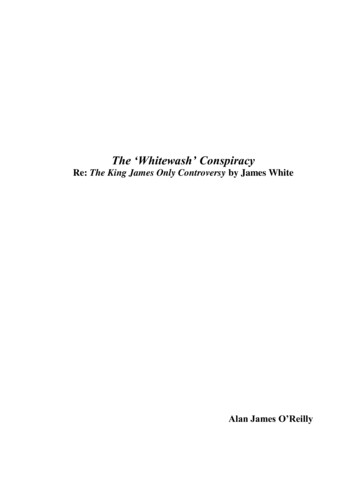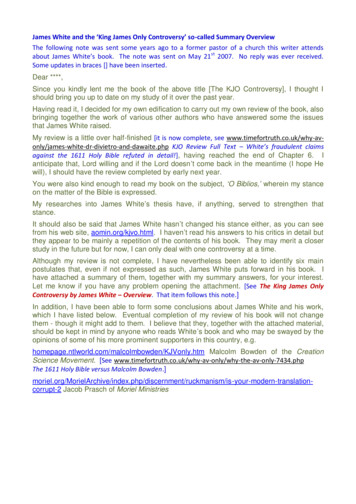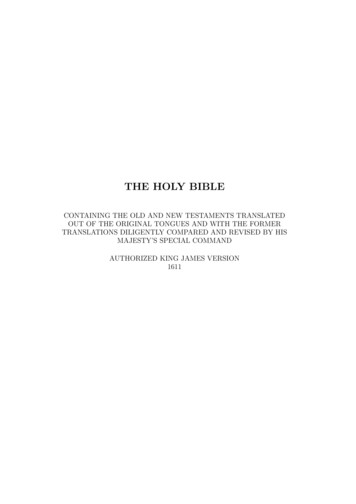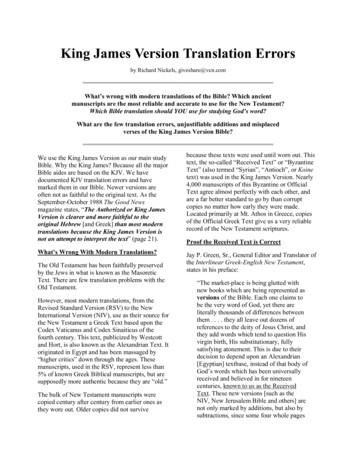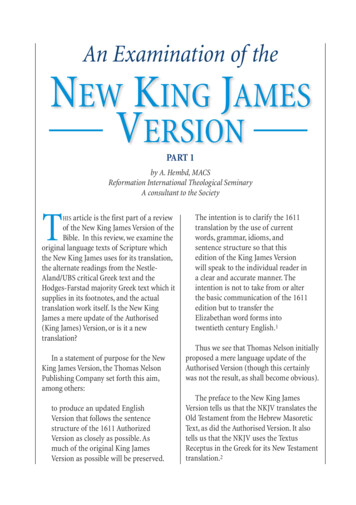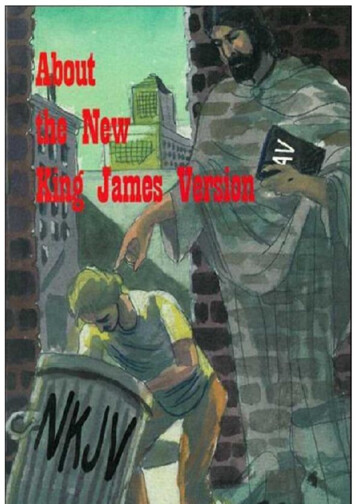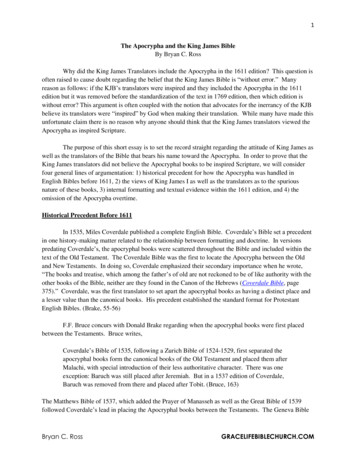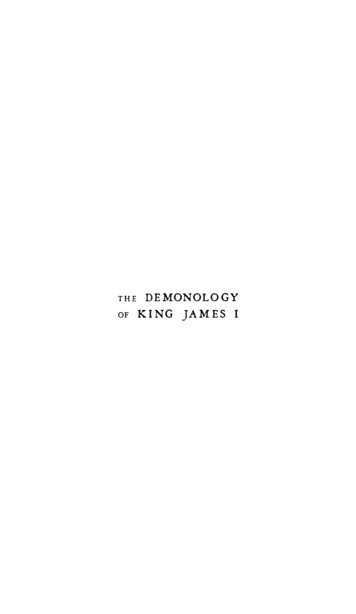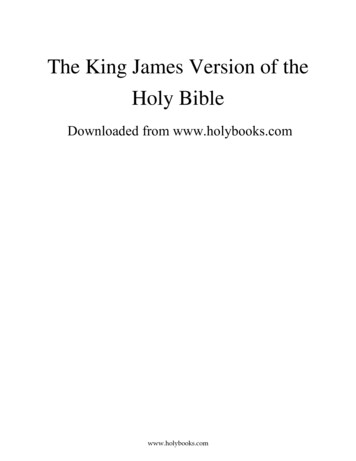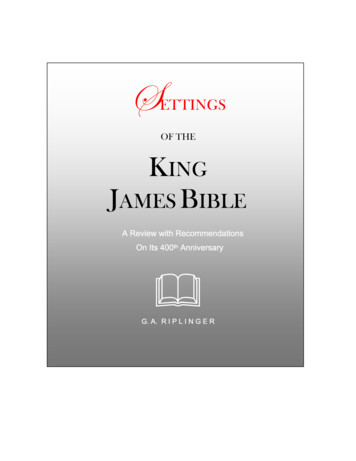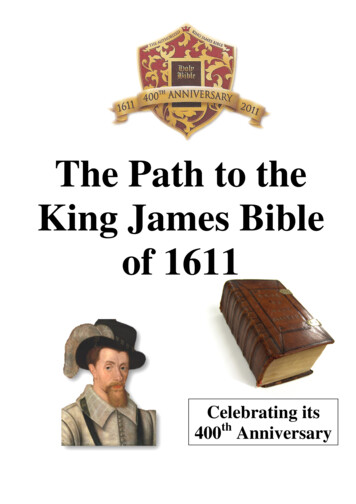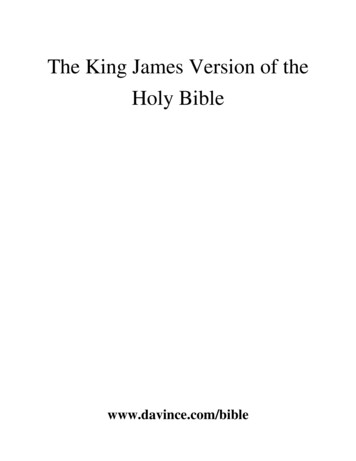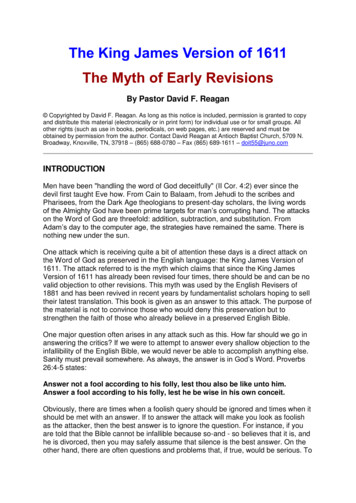
Transcription
The King James Version of 1611The Myth of Early RevisionsBy Pastor David F. Reagan Copyrighted by David F. Reagan. As long as this notice is included, permission is granted to copyand distribute this material (electronically or in print form) for individual use or for small groups. Allother rights (such as use in books, periodicals, on web pages, etc.) are reserved and must beobtained by permission from the author. Contact David Reagan at Antioch Baptist Church, 5709 N.Broadway, Knoxville, TN, 37918 – (865) 688-0780 – Fax (865) 689-1611 – doit55@juno.comINTRODUCTIONMen have been "handling the word of God deceitfully" (II Cor. 4:2) ever since thedevil first taught Eve how. From Cain to Balaam, from Jehudi to the scribes andPharisees, from the Dark Age theologians to present-day scholars, the living wordsof the Almighty God have been prime targets for man’s corrupting hand. The attackson the Word of God are threefold: addition, subtraction, and substitution. FromAdam’s day to the computer age, the strategies have remained the same. There isnothing new under the sun.One attack which is receiving quite a bit of attention these days is a direct attack onthe Word of God as preserved in the English language: the King James Version of1611. The attack referred to is the myth which claims that since the King JamesVersion of 1611 has already been revised four times, there should be and can be novalid objection to other revisions. This myth was used by the English Revisers of1881 and has been revived in recent years by fundamentalist scholars hoping to selltheir latest translation. This book is given as an answer to this attack. The purpose ofthe material is not to convince those who would deny this preservation but tostrengthen the faith of those who already believe in a preserved English Bible.One major question often arises in any attack such as this. How far should we go inanswering the critics? If we were to attempt to answer every shallow objection to theinfallibility of the English Bible, we would never be able to accomplish anything else.Sanity must prevail somewhere. As always, the answer is in God’s Word. Proverbs26:4-5 states:Answer not a fool according to his folly, lest thou also be like unto him.Answer a fool according to his folly, lest he be wise in his own conceit.Obviously, there are times when a foolish query should be ignored and times when itshould be met with an answer. If to answer the attack will make you look as foolishas the attacker, then the best answer is to ignore the question. For instance, if youare told that the Bible cannot be infallible because so-and - so believes that it is, andhe is divorced, then you may safely assume that silence is the best answer. On theother hand, there are often questions and problems that, if true, would be serious. To
ignore these issues would be to leave the Bible attacker wise in his own conceit. Ibelieve that the question of revisions to the King James Version of 1611 is aquestion of the second class. If the King James Version has undergone four majorrevisions of its text, then to oppose further revisions on the basis of an establishedEnglish text would truly be faulty. For this reason, this attack should and must beanswered. Can the argument be answered? Certainly! That is the purpose of thisbook.I. THE PRINTING CONDITIONS OF 1611If God did preserve His Word in the English language through the AuthorizedVersion of 1611 (and He did), then where is our authority for the infallible wording? Isit in the notes of the translators? Or is it to be found in the proof copy sent to theprinters? If so, then our authority is lost because these papers are lost. But, you say,the authority is in the first copy, which came off the printing press. Alas, that copyhas also certainly perished. In fact, if the printing of the English Bible followed thepattern of most printing jobs, the first copy was probably discarded because of badquality. That leaves us with existing copies of the first printing. They are the onesoften pointed out as the standard by which all other King James Bibles are to becompared. But are they? Can those early printers of the first edition not be allowed tomake printing errors? We need to establish one thing from the out-set. The authorityfor our preserved English text is not found in any human work. The authority for ourpreserved and infallible English text is in God! Printers may foul up at times andhumans will still make plenty of errors, but God in His power and mercy will preserveHis text despite the weaknesses of fallible man. Now, let us look at the pressures ona printer in the year of 1611.Although the printing press had been invented in 1450 by Johann Gutenburg inGermany (161 years before the 1611 printing), the equipment used by the printerhad changed very little. Printing was still very slow and difficult. All type was set byhand, one piece at a time (that’s one piece at a time through the whole Bible), anderrors were an expected part of any completed book. Because of this difficulty andalso because the 1611 printers had no earlier editions from which to profit, the veryfirst edition the King James Version had a number of printing errors. As shall later bedemonstrated, these were not the sort of textual alterations, which are freely made inmodern bibles. They were simple, obvious printing errors of the sort that can still befound at times in recent editions even with all of the advantages of useless, but theyshould be corrected in later editions.The two original printings of the Authorized Version demonstrate the difficulty ofprinting in 1611 without making mistakes. Both editions were printed in Oxford. Bothwere printed in the same year: 1611. The same printers did both jobs. Most likely,both editions were printed on the same printing press. Yet, in a strict comparison ofthe two editions, approximately 100 textual differences can be found. In the samevein the King James critics can find only about 400 alleged textual alterations in theKing James Version after 375 years of printing and four so-called revisions!Something is rotten in Scholarsville! The time has come to examine these"revisions."II THE FOUR SO-CALLED REVISIONS OF 1611 KJV
Much of the information in this section is taken from a book by F.H.A. Scrivenercalled The Authorized Edition of the English Bible (1611), Its Subsequent Reprintsand Modern Representatives. This book is as pedantic as its title indicates. Theinteresting point is that Scrivener, who published this book in 1884, was a member ofthe Revision Committee of 1881. He was not a King James Bible believer, andtherefore his material is not biased toward the Authorized Version.In the section of Scrivener’s book dealing with the KJV "revisions," one initial detail isstriking. The first two so-called major revisions of the King James Bible occurredwithin 27 years of the original printing. (The language must have been changing veryrapidly in those days.) The 1629 edition of the Bible printed in Cambridge is said tohave been the first revision. A revision it was not, but simply a careful correction ofearlier printing errors. Not only was this edition completed just eighteen years afterthe translation, but two of the men who participated in this printing, Dr. Samuel Wardand John Bois, had worked on the original translation of the King James Version.Who better to correct early errors than two that had worked on the originaltranslation! Only nine years later and in Cambridge again, another edition came outwhich is supposed to have been the second major revision. Both Ward and Boiswere still alive, but it is not known of they participated at this time. But evenScrivener, who as you remember worked on the English Revised Version of 1881,admitted that the Cambridge printers had simply reinstated words and clausesoverlooked by the 1611 printers and amended manifest errors. According to a studywhich will be detailed later, 72% of the approximately 400 textual corrections in theKJV were completed by the time of the 1638 Cambridge edition, only 27 years afterthe original printing!Just as the first two so-called revisions were actually two stages of one process: thepurification of early printing errors, so the last two so-called revisions were twostages in another process: the standardization of the spelling. These two editionswere only seven years apart (1762 and 1769) with the second one completing whatthe first had started. But when the scholars are numbering revisions, two soundsbetter than one. Very few textual corrections were necessary at this time. Thethousands of alleged changes are spelling changes made to match the establishedcorrect forms. These spelling changes will be discussed later. Suffice it to say at thistime that the tale of four major revisions is truly a fraud and a myth. But you saythere are still changes whether they are few or many. What are you going to do withthe changes that are still there? Let us now examine the character of these changes.III THE SO-CALLED THOUSANDS OF CHANGESSuppose someone were to take you to a museum to see an original copy of the KingJames Version. You come to the glass case where the Bible is displayed and lookdown at the opened Bible through the glass. Although you are not allowed to flipthrough its pages, you can readily tell that there are some very different things aboutthis Bible from the one you own. You can hardly read its words, and those you canmake out are spelled in odd and strange ways. Like others before you, you leavewith the impression that the King James Version has undergone a multitude ofchanges since its original printing in 1611. But beware, you have just been taken bya very clever ploy. The differences you saw are not what they seem to be. Let’sexamine the evidence.
PRINTING CHANGESFor proper examination, the changes can be divided into three kinds: printingchanges, spelling changes, and textual changes. Printing changes will be consideredfirst. The type style used in 1611 by the KJV translators was the Gothic Type Style.The typestyle you are reading right now and are familiar with is Roman Type. GothicType is sometimes called Germanic because it originated in Germany. Rememberthat that is where printings were invented. The Gothic letters were formed toresemble the hand-drawn manuscript lettering of the Middle ages. At first, it was theonly style in use. The Roman Type Style was invented fairly early, but many yearspassed before it became the predominate style in most European countries. Gothiccontinued to be used in Germany until recent years. In 1611 in England, RomanType was already very popular and would soon supersede the Gothic. However, theoriginal printers chose the Gothic Style for the KJV because it was considered to bemore beautiful and eloquent than the Roman. But the change to Roman Type wasnot long in coming. In 1612, the first King James Version using Roman Type wasprinted. Within a few years, all the Bibles printed used the Roman Type Style.Please realize that a change in type style no more alters the text of the Bible than achange in format or type size does. However, the modern reader who has notbecome familiar with Gothic can find it very difficult to understand. Besides somegeneral change in form, several specific letter changes need to be observed. Forinstance, the Gothic s looks like the Roman s when used as a capital letter or at theend of a word. But when it is used as a lower case s at the beginning or in the middleof a word, the letter looks like our f. Therefore, also becomes alfo and set becomesfet. Another variation is found in theGerman v and u. The Gothic v looks like a Roman u while the Gothic u looks like theRoman v. This explains why our w is called a double-u and not a double-v. Soundconfusing? It is until you get used to it. In the 1611 edition, love is loue, us is vs,and ever is euer. But remember, these are not even spelling changes. They aresimply type style changes. In another instance, the Gothic j looks like our i. SoJesus becomes Iefus (notice the middle s changed to f) and Joy becomes ioy.Even the Gothic d is shaped quite differently from the Roman d with the stemleaning back over the circle in a shape resembling that of the Greek Delta. Thesechanges account for a large percentage of the "thousands" of changes in the KJV,yet they do no harm whatsoever to the text. They are nothing more than asmokescreen set up by the attackers of our English Bible.SPELLING CHANGESAnother kind of change found in the history of the Authorized Version are changes oforthography or spelling. Most histories date the beginning of Modern English aroundthe 1500. Therefore, by 1611 the grammatical structure and basic vocabulary ofpresent-day English had long been established. However, the spelling did notstabilize at the same time. In the 1600’s spelling was according to whim. There wasno such thing as correct spelling. No standards had been established. An authoroften spelled the same word several different ways, often in the same book andsometimes on the same page. And these were the educated people. Some of youreading this today would have found the 1600’s a spelling paradise. Not until theeighteenth century did the spelling begin to take a stable form. Therefore, in the last
half of the eighteenth century, spelling of the King James Version of 1611 wasstandardized.What kind of spelling variations can you expect to find between your present editionand the 1611 printing? Although every spelling difference cannot be categorized,several characteristics are very common. Additional e’s were often found at the endof the words such as feare, darke, and beare. Also, double vowels were much morecommon than they are today. You would find mee, bee, and mooued instead me,be, and moved. Double consonants were also much more common. What wouldranne, euill, and ftarres be according to present-day spelling? See if you can figurethem out. The present-day spellings would be ran, evil, and stars. Thesetypographical and spelling changes account for almost all of the so-called thousandsof changes in the King James Bible. None of them alter the text in any way.Therefore they cannot be honestly compared with thousands of true textual changeswhich are blatantly made in the modern versions.TEXTUAL CHANGESAlmost all of the alleged changes have been accounted for. We now come to thequestion of actual textual differences between our present edition and that of 1611.There are some differences between the two, but they are not the changes of arevision. They are instead the correction of early printing errors. That this is a factmay be seen in three things: That this is a fact may be seen in three things: 1) thecharacter of the changes, 2) the frequency of the changes throughout the Bible, and3) the time the changes were made. First, let us look at the character of the changeswere made. First, let us look at the character of the changes made from the time ofthe first printing of the Authorized English Bible.The changes from the 1611 edition that are admittedly textual are obviously printingerrors because of the nature of these changes. They are not textual changes madeto alter the reading. In the first printing, words were sometimes inverted. Sometimesa plural was written as singular or visa versa. At times a word was miswritten for onethat was similar. A few times a word or even a phrase was omitted. The omissionswere obvious and did not have the doctrinal implications of those found in moderntranslations. In fact, there is really no comparison between the corrections made inthe King James text and those proposed by the scholars of today.F. H. A. Scrivener, in the appendix of his book, lists the variations between the 1611edition of the KJV and later printings. A sampling of these corrections is given below.In order to be objective, the samples give the first textual correction on consecutiveleft-hand pages of Scrivener’s book. The 1611 reading is given first; then the presentreading: and finally, the date the correction was first made.1.2.3.4.5.6.7.this thing - this thing also (1638)shalt have remained - ye shall have remained (1762)Achzib, nor Helbath, nor Aphik - of Achzib, nor of Helbath, nor of Aphik (1762)requite good - requite me good (1629)this book of the Covenant - the book of this covenant (1629)chief rulers - chief ruler (1629)And Parbar - At Parbar (1638)
8. For this cause - And for this cause (1638)9. For the king had appointed - for so the king had appointed (1629)10. Seek good - seek God (1617)11. The cormorant - But the cormorant (1629)12. returned - turned (1769)13. a fiery furnace - a burning fiery furnace (1638)14. The crowned - Thy crowned (1629)15. thy right doeth - thy right hand doeth (1613)16. the wayes side - the way side (1743)17. which was a Jew - which was a Jewess (1629)18. the city - the city of the Damascenes (1629)19. now and ever - both now and ever (1638)20. which was of our father's - which was our fathers (1616)Before your eyes are 5% of the textual changes made in the King James Version in375 years. Even if they were not corrections of previous errors, they would be of nocomparison to modern alterations. But they are corrections of printing errors, andtherefore no comparison is at all possible. Look at the list for yourself and you willfind only one that has serious implications. In fact, in an examination of Scrivener’sentire appendix, it is the only variation found by this author that could be accused ofbeing doctrinal. I am referring to Psalm 69:32 where the 1611 edition has "seekGod." Yet, even with this error, two points demonstrate that this was indeed aprinting error. First, the similarity of the words "good" and "God" in spelling showshow easily a weary typesetter could misread the proof and put the wrong word in thetext. Second, this error was so obvious that it was caught and corrected in the year1617, only six years after the original printing and well before the first so-calledrevision. The myth that there are several major revisions to the 1611 KJV should begetting clearer. But there is more.Not only does the character of the changes show them to be printing errors, so doestheir frequency. Fundamentalist scholars refer to the thousands of revisions made tothe 1611 as if they were on a par with the recent Bible versions. They are not. Theoverwhelming majority of them are either type style or spelling changes. The fewwhich do remain are clearly corrections of printing errors printing process. Thesample list given on THE PREVIOUS PAGE will demonstrate just how carefulScrivener was in listing all the variations. Yet, even with this great care, onlyapproximately 400 variations are named between the 1611 edition and moderncopies. Remember that there were 100 variations between the first two Oxfordeditions which were both printed in 1611.Since there are almost 1200 chapters in the Bible, the average variation per chapter(after 375 years) is one third, I.E. one correction per every three chapters. These arechanges such as "chief ruler" and "And Parbar" to "At Parbar." But there is yet onemore evidence that these variations are simply corrected printing errors: the earlydate at which they were corrected.The character and frequency of the textual changes clearly separate them frommodern alterations. But the time the changes were made settles the issueabsolutely. The great majority of the 400 corrections were made within a few years ofthe original printing. Take, for example, our earlier sampling. Of the twenty
corrections listed, one was made in 1613, one in 1616, one in 1617, eight in 1629,five in 1638, one in 1743, two in 1762, and one in 1769. That means that 16 out of20 corrections, or 80%, were made within twenty-seven years of the 1611 printing.That is hardly the long drawn out series of revisions the scholars would have you tobelieve. In another study made by examining every other page of Scrivener’sappendix in detail, 72% of the textual corrections were made by 1638. There is no"revision" issue.The character of the textual changes is that of obvious errors. The frequency of thetextual changes is sparse, occurring only once per three chapters. The chronology ofthe textual changes is early with about three fourths of them occurring within twentyseven years of the first printing. All of these details establish the fact that there wereno true revisions in the sense of updating the language or correcting translationerrors. There were only editions which corrected early typographical errors. Oursource of authority for the exact wording of the 1611 Authorized Version is not in theexisting copies of the first printing. Our source of authority for the exact wording ofour English Bible is in the preserving power of Almighty God. Just as God did notleave us the original autographs to fight and squabble over, so He did not see fit toleave us the proof copy of the translation. Our authority is in the hand of God asalways. You can praise the Lord for that!IV. CHANGES IN THE BOOK OF ECCLESIASTESAn in-depth study of the changes made in the book of Ecclesiastes should help toillustrate the principles stated above. The author is grateful to Dr. Dave Reese ofMillbrook, Alabama, for his work in this area. By comparing a 1611 reprint of theoriginal edition put out by Thomas Nelson & Sons with a recent printing of the KingJames Version, Dr. Reese was able to locate four variations in the book ofEcclesiastes. The reference is given first; then the text of the Thomas Nelson 1611reprint. This is followed by the reading of the present editions of the 1611 KJV andthe date the change was made.1.2.3.4.1:5 the place - his place (1638)2:16 shall be - shall all be (1629)8:17 out, yea further - out, yet he shall not find it; yea farther (1629)11: 17 thing is it - thing it is (?)Several things should be noted about these changes. The last variation ("thing is it"to "thing it is") is not mentioned by Scrivener who was a very careful and accuratescholar. Therefore, this change may be a misprint in the Thomas Nelson reprint.That would be interesting. The corrected omission in chapter eight is one of thelongest corrections of the original printing. But notice that it was corrected in 1629.The frequency of printing errors is average (four errors in twelve chapters). But themost outstanding fact is that the entire book of Ecclesiastes reads exactly like ourpresent editions without even printing errors by the year 1638. That’s approximately350 years ago. By that time, the Bible was being printed in Roman type. Therefore,all (and I mean all) that has changed in 350 years in the book of Ecclesiastes is thatthe spelling has been standardized! As stated before, the main purpose of the 1629and 1638 Cambridge editions was the correction of earlier printing errors. And themain purpose of the 1762 and 1769 editions was the standardization of spelling.
V. THE SO-CALLED JUSTIFICATION FOR OTHER REVISIONSMaybe now you see that the King James Version of 1611 has not been revised butonly corrected. But why does it make that much difference? Although there areseveral reasons why this issue is important, the most pressing one is thatfundamentalist scholars are using this myth of past revisions to justify their owntampering with the text. The editors of the New King James Version have probablybeen the worst in recent years to use this propaganda ploy. In the preface of theNew King James they have stated, "For nearly four hundred years, and throughoutseveral revisions of its English form, the King James Bible has been deeply reveredamong the English-speaking peoples of the world." In the midst of their floweryrhetoric, they strongly imply that their edition is only a continuation of the revisionsthat have been going on for the past 375 years. This implication, which has beenstated directly by others, could not be more false. To prove this point, we will go backto the book of Ecclesiastes.An examination of the first chapter in Ecclesiastes in the New King James Versionreveals approximately 50 changes from our present edition. In order to be fair,spelling changes (cometh to comes; labour to labor; etc.) were not included in thiscount. That means there are probably about 600 alterations in the book ofEcclesiastes and approximately 60, 000 changes in the entire Bible. If you accuseme of including every recognizable change, you are correct. But I am only countingthe sort of changes which were identified in analyzing the 1611 King James. That’sonly fair. Still, the number of changes is especially baffling for a version which claimsto be an updating in the same vein as earlier revisions. According to thefundamentalist scholar, the New King James is only a fifth in a series of revisions.Then pray tell me how "four "revisions" and 375 years brought only 400 changeswhile the fifth revision brought about 60,000 additional changes? That means thatthe fifth revision made 150 times more changes than the total number of changes inthe first four! That’s preposterous!Not only is the frequency of the changes unbelievable, but the character of thealterations are serious. Although many of the alterations seem harmless enough atfirst glance, many are much more serious. The editors of the New King JamesVersion were sly enough not to alter the most serious blunders of the modern bibles.Yet, they were not afraid to change the reading in those places that are unfamiliar tothe average fundamentalist. In these areas, the New King James Version isdangerous. Below are some of the more harmful alterations made in the book ofEcclesiastes. The reference is given first; then the reading as found in the KingJames Version: and last, the reading as found in the New King James Version. 1:13 sore travail; grievous task1:14 vexation of spirit; grasping for the wind1:16 my heart had great experience of wisdom; My heart has understoodgreat wisdom2:3 to give myself unto; to gratify my flesh with2:3 acquainting; guiding2:21 equity; skill3:10 the travail, which God hath given; the God-given task3:11 the world; eternity
3:18 that God might manifest them; God tests them3:18 they themselves are beasts; they themselves are like beasts3:22 portion; heritage4:4 right work; skillful work5:1 Keep thy foot; Walk prudently5:6 the angel; the messenger of God5:6 thy voice; your excuse5:8 he that is higher than the highest; high official5:20 God answereth him; God keeps him busy6:3 untimely birth; stillborn child7:29 inventions; schemes8:1 boldness; sterness8:10 the place of the holy; the place of holiness10:1 Dead flies cause the ointment of the apothecary to send forth a stinkingsavour; Dead flies putrefy the perfumer's ointment10:10 If the iron be blunt; If the ax is dull10:10 wisdom is profitable to direct; wisdom brings success12:9 gave good heed; pondered12:11 the masters of assemblies; scholarsThis is only a sampling of the changes in the book, but notice what is done. Equity,which is a trait of godliness, becomes skill (2:21). The world becomes eternity (3:11)Man without God is no longer a beast but just like a beast (3:18). The clear referenceto deity in Ecclesiastes 5:8 ("he that is higher than the highest") is successfullyremoved ("higher official"). But since success is what wisdom is supposed to bringus (10:10), this must be progress. At least God is keeping the scholars busy (5:20).Probably the most revealing of the above mentioned changes is the last one listedwhere "the masters of assemblies" become "scholars." According to the New KingJames, "the words of scholars are like well-driven nails, given by one Shepherd."The masters of assemblies are replaced by the scholars who become the source ofthe Shepherd’s words. That is what these scholars would like us to think, but it is nottrue.In conclusion, the New King James is not a revision in the vein of former revisions ofthe King James Version. It is instead an entirely new translation. As stated in theintroduction, the purpose of this book is not to convince those who use the otherversions. The purpose of this book is to expose a fallacious argument that has beencirculating in fundamentalist circles for what it is: an overblown myth. That is, themyth that the New King James Version and others like it are nothing more thancontinuation of revisions which have periodically been made to the King JamesVersion since 1611. There is one problem with this theory. There are no suchrevisions.The King James Bible of 1611 has not undergone four (or any) major revisions.Therefore, the New King James Version is not a continuation of what has gone onbefore. It should in fact be called the Thomas Nelson Version. They hold thecopyright. The King James Version we have today has not been revised but purified.We still have no reason to doubt that the Bible we hold in our hands is the very wordof God preserved for us in the English language. The authority for its veracity lies notin the first printing of the King James Version in 1611, or in the character of King
James I, or in the scholarship of the 1611 translators, or in the literaryaccomplishments of Elizabethan England, or even in the Greek Received Text. Ourauthority for the infallible words of the English Bible lies in the power and promise ofGod to preserve His Word! God has the power. We have His Word.
called The Authorized Edition of the English Bible (1611), Its Subsequent Reprints and Modern Representatives. This book is as pedantic as its title indicates. The interesting point is that Scrivener, who published this book in 1884, was a member of the Revision Committee of 1881. He
